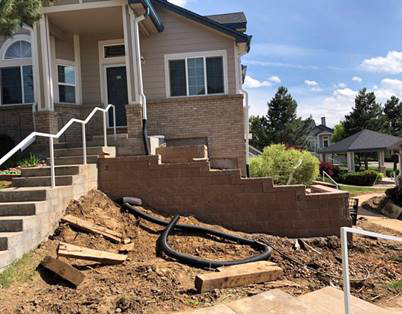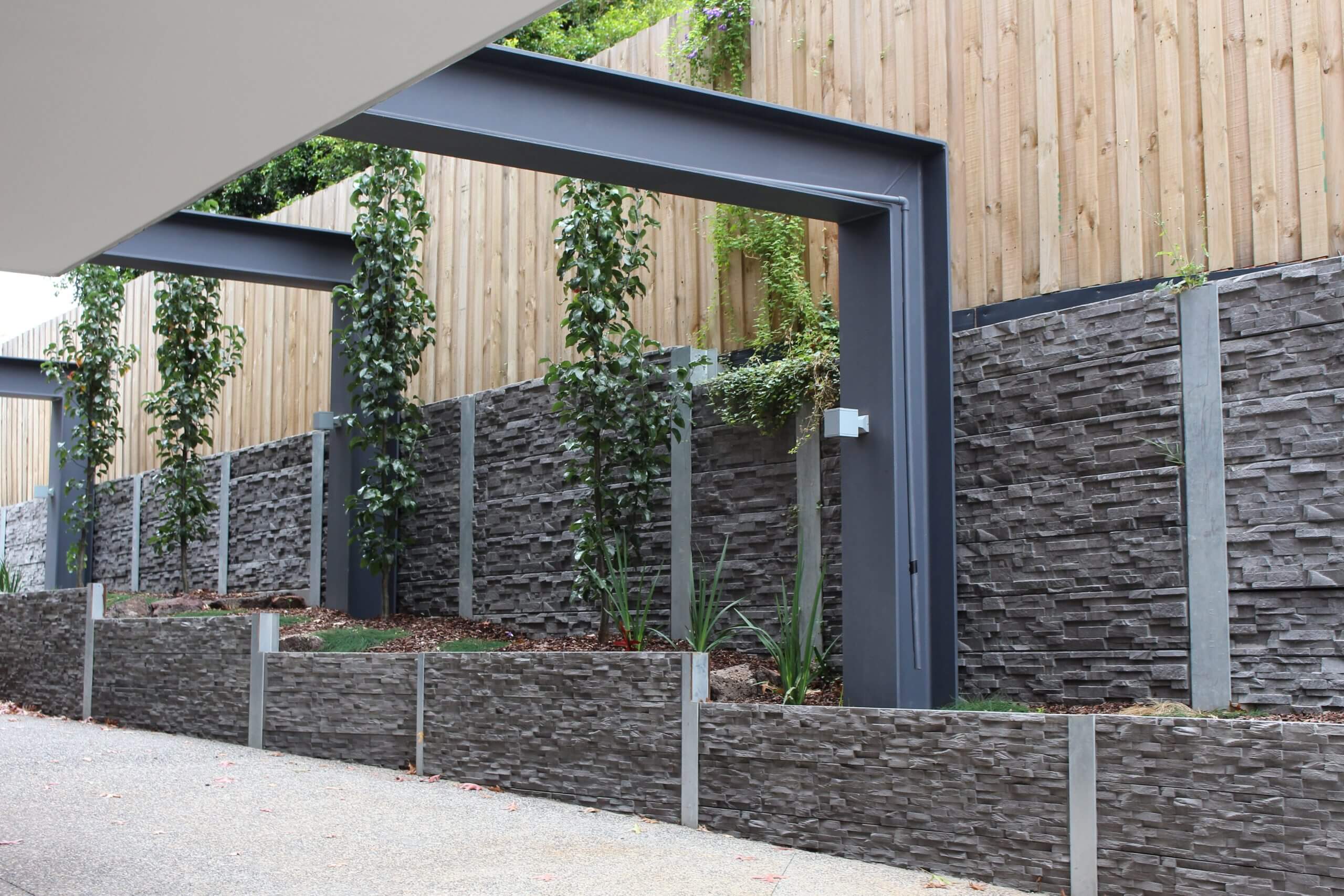Secret Considerations for Structure Efficient Retaining Walls in Your Backyard
When you're thinking about constructing a maintaining wall surface in your backyard, it's crucial to think of several crucial factors. The wall surface's function, the materials you'll make use of, and the certain soil problems can all impact its efficiency and longevity. You'll additionally need to browse regional structure codes and prepare for appropriate water drainage. Yet just how do you assure your style not just satisfies these needs yet additionally improves your landscape? Allow's explore the essential steps with each other.
Understanding the Objective of Your Retaining Wall
When you consider building a maintaining wall, consider its main function: maintaining soil and avoiding erosion. Retaining walls provide vital assistance for sloped landscapes, assisting to keep soil stability. You'll find they're essential in locations where water drainage might or else wash away dirt, leading to costly repair work and landscape damage.
By holding back planet, these walls create level surfaces for gardens, outdoor patios, or paths. This not only improves your lawn's aesthetics yet additionally advertises much better drainage, lowering water pooling in unwanted locations. If you're dealing with steep slopes, a sound retaining wall surface can protect against landslides, making sure security for you and your home.
Ultimately, recognizing the objective of your retaining wall will lead your design choices and assist you produce a practical, resilient structure that satisfies your needs. Take a minute to examine your landscape; it'll pay off in the lengthy run.
Picking the Right Products
When choosing materials for your retaining wall surface, you'll want to think about resilience, appearances, and cost. Each aspect plays a crucial function in ensuring your wall surface stands the examination of time while looking great and fitting your budget. Let's explore just how to make the best choices for your task.
Material Resilience Elements
Picking the ideal materials is essential for the long life and effectiveness of your retaining wall surface, because their resilience straight impacts the wall's capacity to hold up against ecological anxieties. Start by considering your local climate; products like concrete and stone withstand wetness and temperature variations well. If you reside in a location susceptible to hefty rains, go with materials with great drain residential or commercial properties, like gravel or permeable blocks, to stop water build-up.
Some products carry out much better in details soil kinds, so it's vital to match them as necessary. Picking resilient materials warranties your retaining wall stands strong, shielding your lawn for years to come.
Aesthetic Layout Choices
Resilient materials not only guarantee your retaining wall's architectural stability however likewise play a crucial role in its aesthetic charm. Do not neglect concerning the wall's shape-- rounded walls can develop a softer appearance, while straight lines can really feel more organized. By thoroughly choosing products that align with your aesthetic vision, you'll improve your exterior area while ensuring your wall stands strong versus the components.
Cost-Effectiveness Evaluation
Selecting the best products for your retaining wall isn't simply concerning looks; it's also important for your spending plan. When choosing products, take into consideration both upfront costs and lasting resilience. Concrete blocks might be pricier initially, however their longevity can save you money on repair services. On the other hand, hardwood can be much more economical however might need replacement sooner.
Don't neglect to variable in maintenance expenses as well (OKC Precision Retaining Walls). Some products, like all-natural rock, can add beauty and require much less maintenance, while others might require routine treatments
Eventually, weigh the pros and cons of each choice against your budget plan and the wall's intended objective. Spending wisely in materials currently can avoid costly issues in the future. Pick products that stabilize expense and performance successfully.
Analyzing Dirt Problems and Water Drainage
As you begin your project, reviewing dirt conditions and drainage is vital for the success of your retaining wall. Sandy soil drains pipes well but does not have security, while clay soil can retain moisture, leading to push on your wall surface.
Following, examine the slope of your lawn. If water normally streams towards your wall, you'll require to apply a drain service to stop erosion and pressure build-up. Think about setting up perforated pipes or crushed rock backfill behind the wall surface to facilitate drainage.
Finally, observe any nearby trees or plants; their origins can affect soil security. By comprehending your soil conditions and carrying out correct drain, you'll develop a strong structure for your retaining wall surface that stands the test of time.
Abiding With Local Building Codes
Before you begin constructing your retaining wall surface, you require to study local guidelines to ensure conformity. It's necessary to comprehend what permits you should obtain, as this can conserve you from costly penalties or having to renovate your work. Taking these actions seriously will aid you build a risk-free and effective structure.
Research Local Laws
Recognizing regional guidelines is essential when intending your retaining wall job, especially because building codes can vary significantly by location. Look for standards on wall elevation, materials, drainage systems, and structural honesty. By doing your research study upfront, you can guarantee your retaining wall surface meets all essential codes and blends perfectly into your lawn.
Obtain Needed Authorizations
Once you've looked into regional guidelines, the next action is to acquire the essential licenses for your retaining wall surface task. This process warranties your wall follows building regulations and security standards. Reach out to your neighborhood building authority to figure out what permits you require. They may require particular strategies or engineering evaluations, especially for bigger walls. Be prepared to submit comprehensive illustrations, consisting of dimensions and materials. Do not neglect to check if your project affects drain or surrounding properties, as these factors could require additional authorizations. Protecting the appropriate authorizations can save you from pricey fines or having to dismantle your wall later. Keep in mind, following the rules now will lead to a smoother building and construction experience.

Planning the Style and Appearance
As you begin preparing the design and aesthetics of your retaining wall, consider just how it will certainly balance with the bordering landscape. Consider the products you'll make use of-- stone, brick, or concrete-- and just how they'll complement your home's architecture and the natural environments in your backyard. Select shades and appearances that blend flawlessly with existing attributes like patios, paths, or yards.
Following, picture the wall surface's shape and elevation. Bent walls can soften a stiff landscape, while straight lines might share an extra modern look. Do not fail to remember to integrate plants and greenery around the wall for a natural touch; this can enhance its charm and incorporate it right into the setting.
Last but not least, remember performance. Your style needs to not just Check Out Your URL be visually pleasing however also offer its objective successfully. By attentively preparing these components, you'll create a retaining wall surface that improves your yard's beauty while fulfilling its architectural function.
Determining Elevation and Density Requirements
To construct a strong retaining wall, you need to accurately calculate its height and thickness needs based upon the soil conditions and the height of the incline it will support. Start by reviewing the news incline's angle and the kind of dirt, as various soils exert varying amounts of pressure.
For walls over 4 feet high, think about a thickness of a minimum of 12 inches. If the wall is taller, raise the thickness proportionally to keep stability.
Next, determine the elevation of the wall surface by measuring the vertical distance it needs to maintain. For each foot of height, you should usually intend for a density of one-third of the wall's elevation.
Constantly remember to make up extra elements like water drainage and backfill, which can influence your wall surface's style. Correct computations now assure your retaining wall surface stands solid and lasts for several years to come.
Upkeep and Durability Considerations
While maintaining your retaining wall might feel like a reduced top priority, neglecting it can bring about considerable concerns gradually. Routine evaluations are vital; check for splits, bulges, or any kind of indicators of water damage. Addressing these issues early can conserve you from pricey repair services down the roadway.
Watch on drain systems, also. Clogged drains pipes can cause water to develop, putting in stress on your wall and jeopardizing its stability. Clear particles and assurance proper circulation to preserve longevity.
You might also intend to show on sealing your wall surface to safeguard it from dampness and weathering. Depending upon the product, this could call for reapplication every few years.
Finally, landscaping around your wall can support its integrity. Stay clear of planting huge trees nearby, as their roots can weaken the foundation. With positive upkeep, your retaining wall can offer you well for years to find.

Regularly Asked Questions
Can I Construct a Retaining Wall by Myself, or Should I Work with an Expert?
You can definitely build a retaining wall on your own if you have the right tools and expertise. Employing a specialist warranties it's done properly, particularly for bigger or even more complex frameworks. Consider your skill degree before deciding.
What Are the A Lot Of Typical Mistakes Made When Structure Retaining Walls?
When constructing retaining walls, you might ignore proper water drainage, miss using the appropriate products, or neglect support. These typical blunders can cause structural failing, so take your time and strategy thoroughly to stay clear of problems.
How Do I Know if My Retaining Wall Requirements Reinforcement?
You'll understand your retaining wall surface requires support if you see cracks, leaning, or bulging. Look for water merging behind it or soil disintegration near the base. Address these indicators promptly to stop additional damages.
What Plants Appropriate for Landscaping Around a Retaining Wall?
When landscape design around a retaining wall surface, take into consideration making use of low-maintenance plants like succulents, decorative yards, or his comment is here slipping ground covers - OKC Precision Retaining Walls. They'll flourish in those problems and add appeal while stopping soil disintegration around your wall
Just How Can I Avoid Erosion Around My Retaining Wall?
To stop disintegration around your retaining wall surface, you can plant ground cover, usage mulch, and mount drain systems. On a regular basis look for water accumulation and adjust landscape design to redirect drainage far from the wall.
 Barret Oliver Then & Now!
Barret Oliver Then & Now! Joshua Jackson Then & Now!
Joshua Jackson Then & Now! Susan Dey Then & Now!
Susan Dey Then & Now! Jane Carrey Then & Now!
Jane Carrey Then & Now! Dawn Wells Then & Now!
Dawn Wells Then & Now!